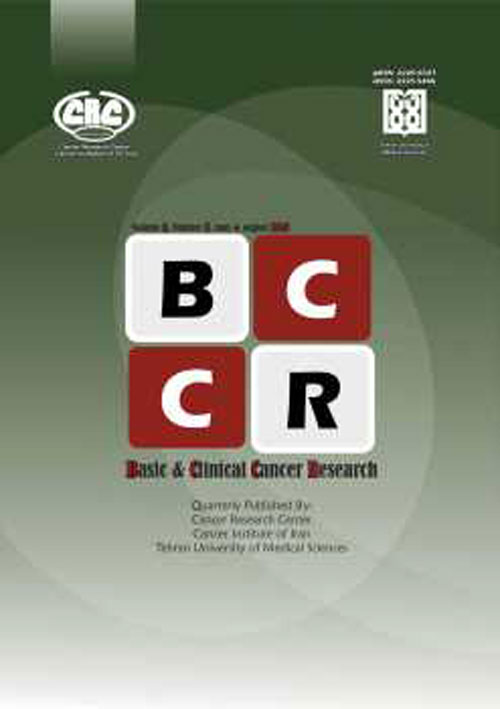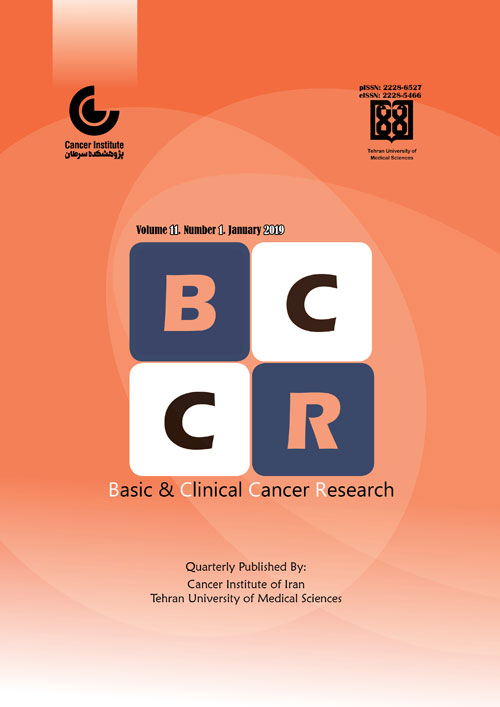فهرست مطالب

Basic and Clinical Cancer Research
Volume:9 Issue: 1, Winter 2017
- تاریخ انتشار: 1396/01/30
- تعداد عناوین: 6
-
-
Pages 1-3
-
Pages 4-11Background And ObjectiveOne of the main reasons of death around the world is Colorectal cancer. The incidence of this cancer has increased in recent years. The aim of this study was to evaluate the survival rate and to define the prognostic factors in Iranian colorectal cancer patients using parametric competing risk model.Materials And MethodsData recorded from 1060 patients with colorectal cancer who registered in Institute for Gastroenterology and Liver Diseases, Shahid Beheshti University of Medical Sciences (Tehran, Iran) from 2004 to 2015 in a retrospective study. Analysis was performed using competing risks model and based on the generalized Weibull distribution. Data analysis was carried out using R software and significance level was regarded as 0.05.ResultsAt the end of follow-up, 380 (35.8%) patients died due to colorectal cancer, 49 (4.6%) patients due to other diseases and 631 (59.5%) patients survived until the end of the study. The mean survival time in studied patients was 56.96±1.46 months with median 45.5 months. According to competing-risks method, only age at diagnosis and body mass index has a significant effect on patients survival time.ConclusionBased on parametric competing risk model, just age at diagnosis and body mass index were significant prognosis of colorectal cancer survival.Keywords: Survival Analysis, Competing risk, Colorectal cancer, Weibull model
-
Pages 12-20BackgroundVascular endothelial growth factor (VEGF) is a key mediator of angiogenesis and as a result acts in tumor invasion. In this study, we investigate the frequency of alleles, genotypes and haplotypes for three VEGF single nucleotide polymorphisms (SNP) in female breast cancer patients and healthy control group.MethodsWe performed a casecontrol study including 214 female patients with pathologically proven breast cancer and 220 female age-matched healthy control subjects. We selected three VEGF candidate polymorphisms -634C/G (rs2010963), -460C/T (rs833061) and -1154A/G (rs1570360). Frequency of alleles and genotypes was determined by TaqMan real-time PCR allelic discrimination assay.ResultsThere was not a significant difference in genotype and allele distributions of the VEGF -460T/C and VEGF -1154A/G between patients and controls. For -634C/G SNP, the frequency of -634G allele was significantly higher in patients than control group (P =0.0003). However the frequency of -634C allele was significantly higher in control group than patients (P =0.0003). When we stratified patient and control groups by age, we observed that the frequency of VEGF -634G/G genotype was significantly higher in patients older than 40 years compared with respective controls (P =0.003).ConclusionsThese findings suggest the association of -634G allele with the presence of breast cancer in our female population. Female carriers with -634C allele show a protective effect against the development of this malignancy and women more than 40 years old with -634G/G genotype might be at increased risk of the disease. Further large-scale studies are required to confirm these findings.Keywords: Breast cancer, Polymorphisms, Vascular endothelial growth factor (VEGF)
-
Pages 21-25Fetuin-A is a major 63-kDa plasma protein synthesized by liver cells and secreted to plasma. Fetuin-A has been suggested to be an extracellular adhesive molecule.Breast tumor cells in the presence of fetuin-A can join and distribute, but the mechanism is not clear. Fetuin-A mediates adhesion by calcium ions, but integrin mediates adhesion by divalent ion manganese and magnesium.Calcium-mediated adhesion is observed in metastatic or more aggressive breast tumor cell line, but not in benign or normal breast epithelial cells. Adhesion and spreading of tumor cells can be mediated only by cellular exosomes carrying histones and fetuin-A.In this article, fetuin A, its role in apoptosis andbreast cancer will be surveyed.Keywords: breast cancer, fetuin A, mechanism, calcium ion
-
Page 27Adrenocortical carcinoma (ACC) is an uncommon disease that accounts for only 0.02% of all cancers. Herein, we report a case of adult ACC with extension into the inferior vena cava and Cushingoid features. A 67-year-old woman was admitted to the surgery service for surgical resection of adrenal mass which was found on hypertension work-up. On physical examination, she was obese and cushingoid with ecchymoses on her skin. The patient was hypokalemic at the time of admission. Spiral CT with contrast of the abdomen and pelvis was done and showed solid mass measuring 10x11 cm, superior to the right kidney and posterior to IVC (inferior vena cava) with anterior displacement of IVC. Microscopic diagnosis was adrenocortical carcinoma with vascular invasion and necrosis (20% of surface area). In conclusion, hypertension can be the most common complaint in ACC patients and the presence of both hypertension and hypokalemia in a case can probably increase suspicion of ACC. Future studies are required to address these complaints.Keywords: Adrenocortical carcinoma, Cushingoid, Inferior vena cava


